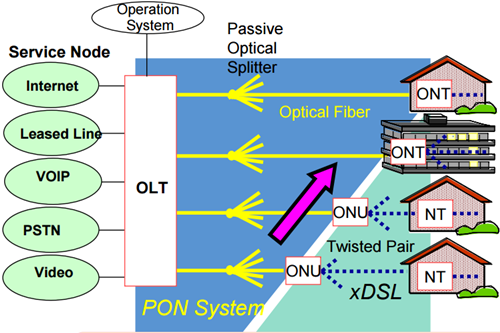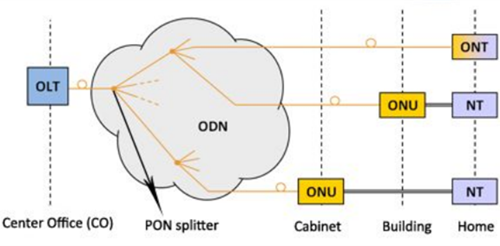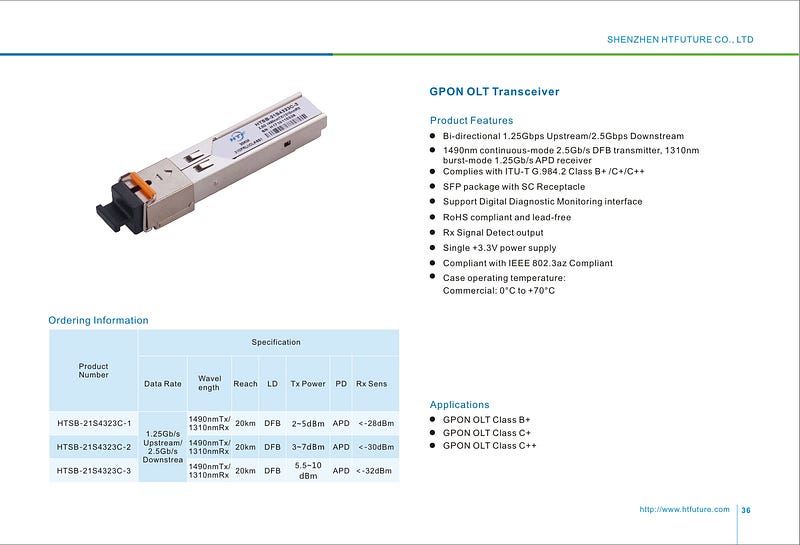Optical access is gaining more interest as the demand for higher and higher bandwidth is getting stronger. Yet the limitation in transport distance and cost has been slowing down penetration of the optical access. Recently a number of alternative transport concepts have been developed to tackle the cost problem as well as the technical ones, the passive optical network (PON) techniques are largely anticipated to be the most economical solutions.
What Is Passive Optical Network?
A passive optical network features a point-to-multipoint (P2MP) architecture to provide broadband access. It is a telecommunications network that uses single, shared optical fiber in which inexpensive optical splitters to divide the single fiber into separate strands feeding individual subscribers. PON is called “passive”, because, other than at the Central Office (CO) and subscriber endpoints, there are no active electronics within the access network. In passive optical system, a single fiber from a central office optical line terminal (OLT) is connected to optical network terminals (ONTs) or optical network units (ONUs) at customer premises. The image below is a PON system.

How Does It Work?
The operation of a PON system is not that complicated. Here presents how it works. As the following picture shows, a PON consists of an OLT at the service provider’s central office and a number of ONUs or ONTs, near end users. In the basic method of operation for downstream distribution on one wavelength of light from OLT to ONU/ONT, all customers receive the same data. To put it simply, an OLT terminates the optical signals to as many as 16 to 128 customers. Hence the bandwidth of the fiber originally at the center office is shared among a group of users. The splitting of the network is accomplished by an optical splitter. These splitters can divide a single optical signal into multiple equal but lower-power signals and distribute the signals to users from OLT to ONU/ONT. The ONU usually communicates with an optical network terminal, which may be a separate box that connects the PON to TV sets, telephones, computers, or a wireless router. ONT and ONU are nearly the same device.

Why PONs?
Dramatic Cost Savings
Optical fiber is drastically less expensive than Ethernet cable. And it can carry a signal 12 miles versus 300 feet for copper wiring. That means passive optical networks don’t require repeaters, switches, cooling, and other gear that’s expensive to purchase, install and operate. And an optical LAN can slash your annual energy costs by two thirds.
Higher Speed Performance for Today and Tomorrow
Single-mode optical fiber can support speeds up to 69 Tbps compared with 10 Gbps for Cat 6 cabling. That’s sufficient capacity to meet the most ambitious communications strategy, eliminating the need for separate lines for converged voice, data and video.
Extremely Secure
In addition to the inherent intrusion protection that optical fiber offers, PON is a natural fit with interlocking alarmed fiber since adjacent strands can be monitored from within the same bundle. Alarm management systems give network managers the means to identify, plan and remediate alarm events using all security assets available at a site. PON also enables you to run multiple classifications through the same conduit.
Conclusion
PON is a highly attractive access solution because of cost and performance advantage, resulting from their nature as all-passive networks, point-to-multipoint architecture, and native Ethernet protocol.
More information about HTFuture’s is available by emailing Ivy: sales6@htfuture.com
Skype: live:sales6_1683
Related Product
(1) Optical module (1.25G SFP, 10G XFP, SFP , CWDM/DWDM, BIDI, 25G, 40G, 100G Module etc),
(2) Wavelength division multiplexer (WDM/CWDM/DWDM/OADM)
(3) Optical Transport Network Product (OEO, OTU, OBP, OLP, EDFA etc)



没有评论:
发表评论